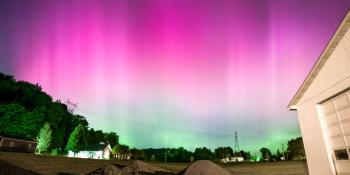Vaata kolmapäev, 27 juuli 2011 arhiivi
Päikese aktiivsuse aruanne
Any mentioned solar flare in this report has a scaling factor applied by the Space Weather Prediction Center (SWPC). Because of the SWPC scaling factor, solar flares are reported as 42% smaller than for the science quality data. The scaling factor has been removed from our archived solar flare data to reflect the true physical units.
Päikese ja geofüüsikalise aktiivsuse aruanne 2011 Jul 27 2200 UTCValminud NOAA © SWPC ja töödeldud SpaceWeatherLive.com-iga
Ühine USAF / NOAA päikese- ja geofüüsikaalase aktiivsuse aruanne
SDF number 208 Välja antud 2200Z kuni 27 Jul 2011IA. Päikese aktiivsete piirkondade ja päikeseaktiivsuse analüüs alates 26-2100Z kuni 27-2100Z Solar activity was moderate. Region 1260 (N18E30)
produced a M1/1n flare at 1607Z as well as numerous C-class flares
during the past 24 hours. This region showed some magnetic
complexity (magnetic class beta-gamma) and changed steadily
throughout the day. Region 1261 (N15E60) is the largest group on the
disk (250 millionths) but is a simple magnetic beta group and only
produced one subflare during the day. New Region 1262 (N16W38) was
assigned and is a small D-type group with a weak delta configuration
in the trailing portion of the group. Despite its magnetic
complexity 1262 did not produce any flares. The eruption of a
filament from the northeast quadrant was observed at about 0620Z and
was associated with a faint, slow coronal mass ejection off the
northeast limb as observed by the LASCO C2 coronagraph beginning at
0642Z.
IB. Päikese aktiivsuse ennustus
Solar activity is expected to be
predominantly low but there is a chance for additional isolated
M-class flares from Region 1260.
IIA. Summaarne geofüüsikaline aktiivsus 26-2100Z kuni 27-2100Z
The geomagnetic field was quiet. The greater than 2 MeV electron flux
at geosynchronous orbit reached high levels during the period.
IIB. Geofüüsikalise aktiivsuse ennustus
The geomagnetic field is
expected to be quiet for the next three days (28-30 July). Recent
analysis from Stereo-B and solar imagery suggest that the previously
anticipated high speed stream from a coronal hole is most likely to
start affecting Earth on 31 July.
III. Sündmuste tõenäosus 28 Julkuni 30 Jul
| Klass M | 40% | 40% | 40% |
| Klass X | 01% | 01% | 01% |
| Prooton | 01% | 01% | 01% |
| PCAF | green | ||
IV. Pikklaine 10.7 cm kiirgus
Vaadeldud 27 Jul 099 Prognoositud 28 Jul-30 Jul 100/100/105 90 päeva keskmine 27 Jul 095
V. Geomagneetiline A-indeks
Vaadeldud Afr/Ap 26 Jul 005/005 Hinnanguline Afr/Ap 27 Jul 005/005 Prognoositud Afr/Ap 28 Jul-30 Jul 005/005-005/005-005/005
VI. Geomagnetilised aktiivsuse tõenäosused 28 Jul kuni 30 Jul
| A. Keskmistel laiuskraadidel | |||
|---|---|---|---|
| Aktiivne | 05% | 05% | 05% |
| Väike torm | 01% | 01% | 01% |
| Suur-tõsine torm | 01% | 01% | 01% |
| B. Kõrgetel laiuskraadidel | |||
|---|---|---|---|
| Aktiivne | 05% | 05% | 05% |
| Väike torm | 01% | 01% | 01% |
| Suur-tõsine torm | 01% | 01% | 01% |
Kõik ajad UTC-s
<< Mine igapäevase ülevaate lehele
Viimane uudis
Viimane foorumi postitus
What makes AR3684 magnetically distinct from AR3685? 3Unproven theories 482May 2024 Geomagnetic Storms from AR 13664 (2) 316"It Was Fake, It Was HAARP" - What? 7Don't we need better high geomagnetic parameters? 7
Veel teemasidToeta SpaceWeatherLive.com-i!
Paljud inimesed külastavad SpaceWeatherLive lehte selleks, et jälgida, mis toimub Päikesel või, kas on oodata virmalisi. Suurema liiklusega on serveri koormus ning maksumus kõrgem. Kui sulle meeldib see, mida me sinu heaks teeme, siis saad sa sellele ka ise natukene kaasa aidata, annetades selle lehe käigus hoidmise ja arendamise heaks. Ette tänades SpeaceWeatherLive meeskond!

Fakte kosmose ilmast
| Viimane X-loide | 15/05/2024 | X2.9 |
| Viimane M-loide | 17/05/2024 | M7.1 |
| Viimane geomagnetiline torm | 17/05/2024 | Kp6 (G2) |
| Plekivabasid päevi | |
|---|---|
| Viimane päikese plekivaba päev | 08/06/2022 |
| Kuu keskmine päikeseplekkide arv | |
|---|---|
| aprill 2024 | 136.5 +31.6 |
| mai 2024 | 157.2 +20.7 |
| Viimased 30 päeva | 174.3 +64.2 |


